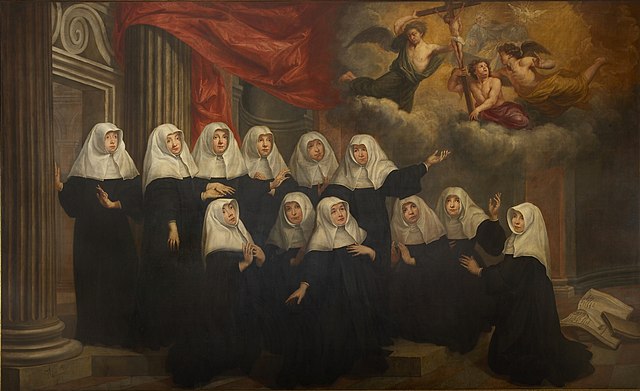The democracy of nuns
The exceptional political organization of the female convents of the modern age

Painting by the Flemish painter Jan Van Helmont representing a group of nuns from the convent of Antwerp, Belgium. Image from Commons.wikimedia.org
In the female convents of the Counter-Reformation, the social distinctions typical of the modern age survived: the nuns were divided into choir nuns, of noble origin and part of the convent choir, and lay sisters, of humble extraction and serving as domestics of the choir nuns. The right to sit in the chapter, the assembly of voting nuns, was reserved for choir nuns who had taken vows for at least two years. The chapter was primarily responsible for electing the main offices of the convent. First, there was the abbess, who was in charge of the spiritual direction of the monastery, also liaising with ecclesiastical authorities and secular powers. To be Elected Abbess, a nun had to have at least 8 years of monastic life and be at least 40 years old; she needed at least 2/3 of the chapter's votes and the bishop's approval. The six "listeners" or "prudent ones" were also elected. The latter were tasked with advising the abbess, instructing novices, and listening (on their part) to the conversations between the nuns and their visitors. The sisters also dealt with finances: the convents owned properties and invested in agricultural activities, shops, and trade, significantly contributing to the local economy. For financial decisions, the abbess's power was limited: in Venice, for example, she could decide alone on matters concerning a maximum of 10 ducats; from 10 to 50 ducats, the advice of the six listeners was required, and for amounts exceeding 50 ducats, the majority of the chapter was needed. To prevent corruption and favoritism, bishops reiterated the importance of the secrecy of the vote, also requiring all nuns to confess and not receive visitors before the votes. Furthermore, to avoid conflicts of interest, nuns with personal or family interests in the matters discussed were excluded from the chapter. This particular form of three-level political organization has been compared to the mixed government of Republican Rome and the Most Serene Republic: there was indeed a "monarchical" power (the abbess), an "oligarchic" power (the listeners), and a "democratic" power (the chapter).
Book: Mary Laven, Monache: vivere in convento nell'età della Controriforma , Il Mulino, 2004
2025-09-26
Salvatore Ciccarello
